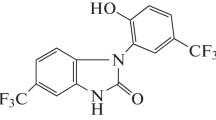Abstract
Thiazole analogs of vitamin B1 3-decyloxycarbonylmethyl-4-methyl-5-(2-hydroxyethyl)thiazole chloride (DMHT) and 3-decyloxycarbonylmethyl-4-methylthiazole chloride (DMT) suppress quantum transmitter release from nerve terminals in the frog skeletal muscle. Intraperitoneal administration of these compounds to mice suppresses behavioral motor activity, diminishes motor coordination, and suppresses the corazol-induced seizures. Application of DMHT reduces the α-latrotoxin-induced massive transmitter release from nerve terminals in the frog skeletal muscle and suppresses latrotoxin-induced seizures in mice. In model experiments, DMHT blocks Ca2+ entry through the ion channels formed by α-latrotoxin in a bilayer lipid membrane. It has been suggested that the effectiveness of DMHT and DMT is determined by the presence of a thiazole cycle in their molecules that, among all endogenous biologically active compounds, is possessed only by vitamin B1 and its metabolites.
Similar content being viewed by others
References
A. V. Romanenko, “Effect of thiamine on neuromuscular transmission in the frog,”Neirofiziologiya,17, No. 6, 794–800 (1985).
A. V. Romanenko, “Effect of thiamine on synaptic junctions of various types,”Neirofiziologiya,18, No. 5, 621–629 (1986).
A. V. Romanenko, V. M. Gnatenko, and I. A. Vladimirova, “Effect of thiamine on neuromuscular transmission in smooth muscle,”Neirofiziologiya/Neurophysiology,26, No. 6, 449–457 (1994).
A. V. Romanenko, “A new way of muscle activity regulation: thiamine participation in neuromuscular transmission,” in:Muscle and Motility, Vol. 2, Andover, Hampshire (1990), pp. 151–153.
V. A. Dyatlov, “Effect of thiamine on the processes ensuring acetylcholine release in frog neuromuscular synapses,”Neirofiziologiya/Neurophysiology,26, No. 4, 291–298 (1994).
A. V. Romanenko, “The action of thiamine on the electrophysiological properties of muscle and neuromuscular transmission,” in:Physiology and Pharmacology of Smooth Muscle, Varna (1985), p. 105.
A. V. Romanenko, “Effect of pyrithiamine in neuromuscular synapse,”Dokl. Akad. Nauk Ukrainian SSR, Ser. B, No. 1, 80–82 (1989).
A. V. Romanenko, M. L. Zinov'eva, and N. V. Kokshareva, “Electromyographic study of pyrithiamine effect in mouse skeletal muscle,”Dokl. Akad. Nauk Ukrainian SSR, Ser. B, No. 11, 74–77 (1989).
A. I. Vovk, I. V. Murav'eva, and A. A. Yasnikov, “Catalytic effect of thiazole salts in reaction of oxidation of aldehydes by quinones. A new model of pyruvatdehydrogenase complex,”Zh. Obshch. Khimii,55, No. 7, 1574–1579 (1985).
A. I. Vovk, I. V. Murav'eva, and A. A. Yasnikov, “Quinone reduction in reaction of oxidative decarboxylation of pyruvate, catalyzed by thiazole salts,”Zh. Obshch. Khimii,57, No. 2, 456–460 (1987).
A. V. Romanenko and A. I. Vovk, “Action of 3-benzylthiazole chloride on neuromuscular transmission,”Dokl. Akad. Nauk Ukrainian SSR, Ser. B, No. 11, 75–77 (1988).
A. S. Sadykov, A. A. Akhunov, and Sh. I. Salikhov,The Black Widow Spider Venom [in Russian], Fan, Tashkent (1985).
M. Bachir, J.-P. Riffaud, J.-Y. Lacolle, et al., “Synthesis and anticonvulsant activity of some 2-(N-substituted glycylamino)-4-methyl thiazoles,”Eur. J. Med. Chem.,25, 71–74 (1990).
S. L. Mironov, Yu. V. Sokolov, A. Chanturia, and V. K. Lishko, “Channels produced by spider venoms in bilayer lipid membrane: mechanism of ion transport and toxin action,”Biochim. Biophys. Acta,862, No. 1, 185–198 (1986).
L. L. Rubin, A. Gorio, and A. Mauro, “Effect of concanavalin A on black widow spider venom activity at the neuromuscular junction: implications for mechanisms of venom action,”Brain Res.,143, No. 1, 107–124 (1987).
M. C. Tzeng and B. S. Tian, “Beta-bungarotoxin antagonizes the effect of alpha-latrotoxin from black-widow-spider venom on the neuromuscullar junction,”J. Neurobiol.,15, No. 2, 157–160 (1984).
F. Dreyer, F. Rosenberg, C. Becker, et al., “Differential effects of various secretagogues on quantal transmitter release from mouse motor nerve terminals treated with botulinum A and tetanus toxin,”Naunyn-Schmiedeberg's Arch. Pharmacol.,335, No. 1, 1–7 (1987).
O. N. Osipenko, A. V. Romanenko, E. A. Petrushenko, and Ya. T. Terletskaya, “Effect of α-latrotoxin on synaptic transmission between identified neurons in central nervous system of the snall,”Neirofiziologiya,24, No. 4, 430–437 (1992).
O. N. Osipenko, A. V. Romanenko, E. A. Petrushenko, and Ya. T. Terletskaya (Terlezkaya), “The effect of α-latrotoxin on synaptic connection between identified neurons in the brain molluscHelix pomatia L.,”Toxicon,31, No. 9, 1123–1130 (1993).
A. I. Vovk and A. V. Romanenko, “Thiazole analogs of vitamin B1 that depress neuromuscular transmission,”Dokl. Akad. Nauk Ukrainian SSR, Ser. B, No. 5, 119–121 (1993).
É. I. Grebinozhko and A. I. Nikolaenko, “Purification of α-latrotoxin using the technique of high-performance liquid chromatography,”Ukrainian Biokhim. Zh.,59, No. 5, 93–96 (1987).
P. G. Kostyuk,Microelectrode Technique [in Russian], Izdatel'stvo Akad. Nauk Ukraininan SSR, Kiev (1960).
L. L. Voronin, “Quantal analysis of postsynaptic potentials,”Neirofiziologiya,11, No. 5, 491–505 (1979).
D. P. Matyushkin, T. M. Drabkina, and I. A. Shabunova, “Quantitative estimation of presynaptic apparatus in single and multiple synapses,”Usp. Fiziol. Nauk,11, No. 2, 49–70 (1980).
S. A. Andronati, G. Ya. Avrutskii, A. V. Bogatskii, et al.,Phenazepam [in Russian], Naukova Dumka, Kiev (1982).
V. V. Gazura,Techniques of Primary Pharmacological Study of Biologically Active Substances [in Russian], Meditsina, Moscow (1974).
P. Mueller, D. O. Rubin, H. T. Tien, and W. G. Walscott, “Reconstitution of cell membrane structurein vitro and its transformation into excitable system,”Nature,194, 979–980 (1964).
A. E. Shamoo and D. A. Goldstein, “Isolation of ionophores from ion transport systems and their role in energy transduction,”Biochim. Biophys. Acta,472, 13–53 (1976).
V. A. Kokunin, “Statistical data treatment at small number of experiments,” Ukrainian Biokhim. Zh.,47, No. 1, 776–791 (1975).
L. Bettendorff, “Thiamine in excitable tissues: reflections on a non-cofactor role,”Met. Brain Dis.,9, No. 3, 183–209 (1994).
V. A. Zhukareva, O. Ya. Shaturskii (Shatursky), V. K. Lishko, et al., “Latrotoxin-like properties of a protein from brain,”FEBS Lett,300, No. 3, 219–221 (1992).
V. B. Prozorovskii, “The probit-analysis of lethality curves as performed using the least squares method,”Farmakol. Toksikol.,25, No. 1, 115–120 (1962).
A. Grasso, “Preparation and properties of a neurotoxin purified from venom of black widow spider (Latrodectus mactans tredecimguttatus),”Biochim. Biophys. Acta,439, No. 2, 406–412 (1976).
Author information
Authors and Affiliations
Additional information
Neirofiziologiya/Neurophysiology, Vol. 27, No. 5/6, pp. 368–374, September–December, 1995.
Rights and permissions
About this article
Cite this article
Romanenko, A.V., Vovk, A.I. & Shaturskii, O.Y. Effects of thiazole analogs of vitamin B1 on neuromuscular transmission and α-latrotoxin-induced transmitter release in skeletal muscles. Neurophysiology 27, 291–296 (1995). https://doi.org/10.1007/BF01081907
Received:
Issue Date:
DOI: https://doi.org/10.1007/BF01081907



